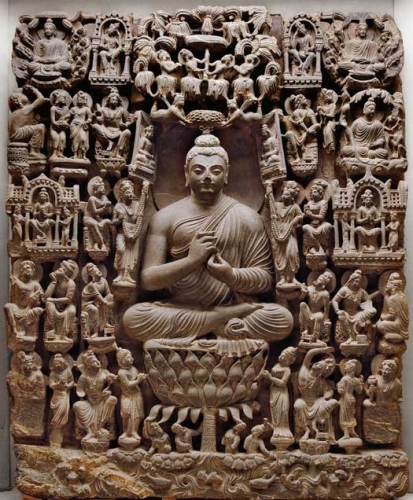
Jed Perl at the New Republic, on the Asia Society’s ongoing exhibition, The Buddhist Heritage of Pakistan: Art of Gandhara,
Nearly two thousand years ago, in the stark terrain where modern day Afghanistan and Pakistan meet, a sculptural tradition emerged that joins opulent forms and contemplative feelings and is unlike anything else in the history of world art. Although we know next to nothing about the sculptors who in the 2nd and 3rd Centuries CE developed what amounts to the first great act in the history of Buddhist art, a visitor to “The Buddhist Heritage of Pakistan: Art of Gandhara,” the exhibition now at Asia Society in New York, cannot fail to respond to the emotional texture of the work. Carving into dark gray schist, a stone with a dense materiality, these sculptors were giving shape to the Buddhist critique of materiality. There are scenes from the life of Siddhartha and standing and seated Buddhas, as well as themes drawn from Greek mythology and figures that suggest Prehistoric talismans. Despite the intimate relationship that these sculptors had with the classical forms of Greco-Roman art, their work exudes a wonderfully anti-classical fervor, a willingness to embrace confusions and pursue possibilities, to go where no artists had gone before. While I am reluctant to ascribe anything like a modern individualism to these anonymous ancient artists, there is a zest and a freedom to their carving that bespeaks an altogether familiar pleasure in the powers of invention. The image of Buddha is human, sensuous, unpredictable—not yet the gorgeously static abstraction of much later Chinese, Japanese, and Tibetan art.
Originally slated to open last March, and for some months a victim of what Melissa Chiu, the director of the Asia Society Museum, has called “political turmoil and tensions in the U.S.-Pakistan relationship,” “The Art of Gandhara” will quite naturally leave some museumgoers thinking about matters of national identity, political change, and religious intolerance that have no immediate relationship with the works on display. Such thoughts are by no means irrelevant. It was in March, 2001 that the Taliban demolished two monumental 6th Century CE Buddhas, 121 and 180 feet high, carved into the live rock in Bamiyan. By dynamiting these gigantic Buddhas, which the Taliban dismissed as idols, the Islamic fundamentalists eradicated one of the wonders of the world and the last great architectural survivals of a lost civilization.
Read the whole piece here.
Browse works of Gandharan art at Himalayan Art Resources here
Thank you for subscribing to Tricycle! As a nonprofit, we depend on readers like you to keep Buddhist teachings and practices widely available.